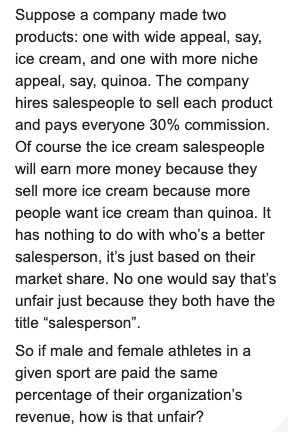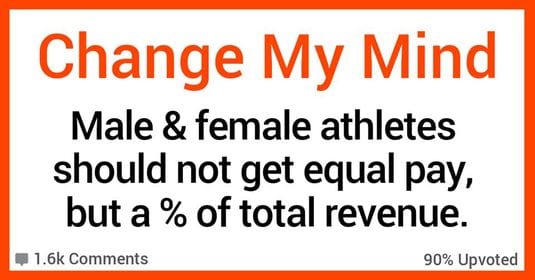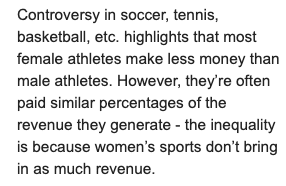Trending Now
A hot topic in sports like basketball, tennis, and soccer is that women’s teams and individual athletes are being paid lower salaries, despite working just as hard at the same job – and in the case of U.S. women’s soccer in particular, actually doing the same job better.
Many arguments have been made that try to justify men’s teams making more money – the men play more games/matches/hours, they make the leagues more money, et al – but none of them really make sense to a lot of people.
This guy on Reddit thinks that it would be fair to pay players based on the amount of revenue a league generates in a salary year, which would make it “fair” to pay, say, WNBA players less than NBA players.

Image Credit: Reddit
He wants people to change his mind – or try to – and these 14 people gave it their best shot.
14. Okay but you’ll lose the best salespeople.
Suppose you’re a sales person for a company and get told to exclusively sell a product that the company gives magnitudes less investment in development and marketing than their other products. Be a bit miffed wouldn’t you.
You hardly be surprised if some otherwise great sales people wouldn’t even bother, and go get a career were they have a chance of making a decent living instead. Further exacerbating the issue
13. Part of the original conception is wrong.
So if male and female athletes in a given sport are paid the same percentage of their organization’s revenue, how is that unfair?
I don’t think it is. But they’re not.
” He estimated that WNBA player salaries constitute 22 percent of league revenue, while NBA player salaries amount to roughly 50 percent of league revenues. The fact that NBA players get a much larger piece of the revenue pie does seem to say something about how each respective league values its players. “
12. A different perspective.
I feel like if the roles were swapped, though, you wouldn’t feel this way.
11. What if a team is taking a loss for business reasons?
A vast number of sports teams run at a loss at different times. The English premiere League for example had to put in place rules that mean a club can’t make a loss exceeding £105million because it happened so regularly. How would you pay players if they are to be paid from profit when your club might make a £70million loss?
And of course all of these things are completely open to manipulation and not to mention many competitions don’t want the team with the most money to constantly be able to pay the highest wages and therefore attract the best players, this kills the competition a bit.
10. In real numbers.
Using round numbers, the NBA salary cap is $100M. The salary cap is 50% of revenue, so the average team makes $200M in revenue. It’s hard to find profitability data on teams, but a few years ago Forbes reported that the 5 most profitable teams make $37M per year, and the least profitable lose money (keep in mind this operations, not valuation). So let’s call it $10M of profit on average. So after players and profit they have $90M of expenses.
There are some costs that just come with the team existing, fixed costs. For argument’s sake, let’s say that a team is going to spend $25M per year just to exist. That’s for things like the league office, team offices, stadium rent, game day staff, etc. The rest of the costs are variable – coaches salaries, player salaries, travel, etc. What goes in each bucket isn’t super important (other than salaries), but let’s just for argument’s sake assume that the team’s financial statements look like this:
Revenue: $200M
Players: $100M (50%)
Fixed Costs: $25M (12.5%)
Variable Costs: $65M (32.5%)
Profit: $10M (5%)The average WNBA team has about $60M in revenue, per HuffPo. Let’s say that the players also want 50% of revenue as salary, their fixed costs are more efficient and cost $20M instead of $30M, and they incur variable costs at the same rate as the NBA. Here’s what their financials look like:
Revenue: $60M
Players: $30M (50%)
Fixed Costs: $20M (33%)
Variable Cost: $19.5M (32.5%)
Profit: -$9.5M (-16%)Basically, because there are fixed costs to running a team that don’t get higher as the league gets bigger or makes more money, the NBA should be giving a higher percentage to the players as they make more revenue because the owners have less of a fixed cost burden to cover.
9. You have to spend money to make money.
Cross promotion? Women’s sports don’t hardly get any promotion, and that’s part of the problem.
If women’s sports were turned into a product that was more appealing and more accessible to women, they would make a lot more money, etc. I wouldn’t be at all surprised if some men out there are purposely doing what they can to keep them small, so they don’t have to share the pie or the attention.
8. A self-fulfilling prophecy.
I’ve really come around to the idea that it’s not as simple as “people don’t want to watch women’s sports as much.” I think there’s a positive feedback loop between women’s sports often not getting as much attention/airtime from networks —-> people don’t treat women’s sports with the same importance —–> ratings are lower —-> networks give them less airtime.
I’d be a lot more amenable to your equal revenue idea if the two divisions were given the same airtime, coverage, respect by the media.
7. The playing field isn’t level to begin with.
It’s actually a little more complex IMHO. Women should be paid more than the dollar amount of their respective league. Lets take the WNBA. Their league is not super profitable. At all. So why does it stick around? Because it ‘is’ actually very profitable. It’s just that WNBA teams don’t see the profits and it’s why the NBA keeps the league solvent and alive.
It’s essentially a marketing program aimed at introducing half of society that has less interest in sports to the league. Especially as younger girls. The WNBA has been a major plank in the NBA’s marketing strategy since it’s inception and the investment the NBA makes pays dividends in their expansion into the female demographic earning them lots and lots of money.
Women ballers really deserve a larger percentage of their own league’s profit because it represents real NBA dollars and the help money from the NBA to keep it alive isn’t listed as ‘profit’ in terms of the players but they absolutely deserve some of it.
6. The athletes can’t switch leagues.
I think a huge difference in your analogy is that people can choose whether to sell ice cream or sell quinoa. Any salesperson could decide that they don’t want to sell quinoa, and try to go for a different job where they sell ice cream.
But a WNBA athlete can’t simply switch from the WNBA to the NBA. A closer analogy would be saying that in a given company, it is company policy for women to sell quinoa but for men to sell ice cream. I could definitely be missing something in your analogy, but I think you were missing something too.
5. Everyone can’t be the ice cream salesmen, though.
If everyone had an equal shot at being an ice cream salesman as they did at a quinoa salesman, then I’d be inclined to agree with you. But what if the ice cream division only hired white salesmen, and the quinoa division only hired black salesmen? Perhaps we can even set your hypothetical in a segregationist country where there’s a law that black salesmen can’t sell sugary products, so the company doesn’t even have a say over which race of worker they hire for which position.
Even though the company could say that they pay all their salesmen with the same structure, the reality would be that the company were enforcing and cementing unequal pay for equal work, even under the guise of equality. They would cry that they can’t do anything about it, sure, because consumer preferences just tend toward ice cream. And the law says that they can’t hire black salesmen to sell ice cream, after all. But the reality is that their ice cream division makes so much profit that they could easily pay their black salesmen the same amount and simply choose not to. And their real colors would become especially apparent if quinoa sold way, way better in Soccerville, but the ice cream salesmen there still got paid more.
My extension of your ice cream/quinoa example is what really happens in sports. Because of the nature of sports and physical competition, I agree with the prevailing opinion that it’s sensible for the companies and organizations that run sports leagues to (generally) separate leagues into men’s and women’s divisions. But, given that this is a reality that sports organizations don’t really have the ability to change, they should have an obligation to pay their female athletes a comparable amount to their male athletes. To not do so, especially when the ability to do so is there, is to continue enforcing an unequal social structure that may not be their fault but that they could very well take an active role in equalizing.* Sports leagues have the ability to do this – very easily – yet neglect to do this. Additionally, the fact that the US women’s soccer team is far better than the men’s team and brings in more revenue per game, but that their players are still paid less than the objectively less-profitable and less-competitive men, shows that, in reality, it’s not all about the revenue. It’s at least in part about passively enforcing the cultural norm that men’s sports are more valuable than women’s sports.
*This is essentially the core idea of affirmative action, and it’s why I chose a race-based example. I’m not sure if you intend to or not, but your argument can be very easily extended into an anti-affirmative action position, so you need to be willing to defend that too if you defend the gender differences in athletes’ pay.
4. It would kill sports.
percentage of revenue would kill a lot of sports, and isn’t really reasonable, say it costs x to host and event. Group a earn y in revenue and group b earn z in revenue where x< y< z. if you pay b .4 of z, then the profit of the institutions is (.6z – x).
Let’s say that x is equal to .5z, then the institution pockets .1z. If, then, y is .8z, and you pay them .4 of their revenue, then they make .32z. x is still .5z, now the institutions are operating at a net loss of .02z. And they would choose to not participate unless there was some other positive externality or an expectation of growth.
These last two things are also a reason I think that holding to a strict ratio wouldn’t be good.
For example the WNBA existing is of tremendous value to the NBA and NBA players, it makes sense for the NBA to subsidize the WNBA, and potentially end up with players being payed more than total revenue.
3. Gender roles and norms play a part.
Consider roller derby. Men should, by all means, outperform women and their pro teams should be paid more. And yet women’s teams are the ones that get televised and bring in money. I’ve never watched a men’s roller derby match personally. That’s because it’s seen as a women’s sport and is marketed to women.
Other sports that are traditionally considered girl sports get similar attention, though I’m not familiar with how their players are paid. Essentially, revenue made and popularity is rarely a function of raw output of athletes but rather the marketability of the teams which absolutely has to do with gender of the athletes and audience.
So overall it’s mainly the result of gender roles and norms in sports that keeps the pay disparity as can be seen, as another commenter pointed out, by thing’s like US women’s soccer, where they outperform the men’s teams in terms of revenue and popularity and still don’t get paid the same.
2. There are an equal number of salesmen.
Sure, that’s fair (although idk how appropriate the ice cream vs quinoa example is, I get ur point but in that case there would just be less quinoa salesmen in the first place), but it ain’t what’s happening. For example, the US men’s soccer team earns less than the women’s soccer team. It’s a rare exception, but our men’s team is ass and our women’s team is really good, so it happens. However, the women still made less. So yes, you’re 100% right that women don’t deserve the same amount just cuz “equality”, I think ur misinterpreting the issue.
I will expand on this though: men and women aren’t always paid the same cuz they’re handled differently for whatever reason. Back to my US soccer example, women are given a contract with guaranteed pay in addition to an opportunity to earn bonuses for performance. Men only make money for performance.
If we assume the teams play 20 games per year which seems to be an average that the internet thinks is correct, then if they are all losses they make the same amount: men make 5k per loss, while women make nothing for a loss but have a 100k base salary. 5k*20=100k. However, men make slightly more if they win than women do if they win. I don’t know how this equates in terms of earnings because technically women still could make more money than men in certain scenarios.
Anyway, people do tend to oversimplify issues like this. There just isn’t a simple way to fix a problem like this. That’s the problem with how some people attack gender issues: with oversimplification. Oversimplify anything (the wage gap, pink tax), and it seems terrible. Rationalize it and it ain’t so bad anymore.
1. He’s making a lot of assumptions.
This is a very big assumption. Based on this assumption, your view makes sense and is hard to argue against.
However, I must ask you to reconsider this view. If this were the only reason, people would only watch the best sport, the best league in that sport and the best sports team in that league. Yet sports leagues exist around the world. The point I’m making is, complicated factors go into watching sport.
A much more reasonable assumption would be, people watch sport for the entertainment value. That would better explain why all sorts of sports leagues get watched. It accounts for why wrestling federations around the world get decent viewership even though the majority are fake and orchestrated.
Another factor is the cultural aspect, a local team or a local league will get more interest than a foreign team/league. A game that excites a populace will have more viewership than one that doesn’t. Cricket finds it harder to be relevant in America compared to baseball or football, regardless of how good the cricketers are.
Sports ability is also a factor, but not the primary factor, and arguably not a major factor either. A league with terrible sportsmen will get low viewership, but once ability exceeds a passing threshold, it doesn’t matter anymore. Sportsmen get better by the year, but that doesn’t mean previous generations got less viewership or support.
A sports league that is well organized, culturally relevant (through advertising for example) will find itself improving in sports ability. Women’s leagues lack the cultural relevancy and lacklustre effort is dedicated towards improving that.
You’ll find a lot of the comments are basing their assumptions on lack of cultural relevancy while you’re view is based on sports ability. This gap leaves a lot of room for frustration. Frustration because both views flow quite naturally from their base assumptions.
I do think that equal and fair are not always the same thing.
That said, in his example, I also wouldn’t be working for that company for very long if my efforts – in my ASSIGNED LINE OF WORK – were just as great as someone else’s, but my pay was less.
I’d love to hear your thoughts in the comments!







